As a quick note: if you have not played this game before reading this, I highly recommend you do so. This is a game which I think well merits the praise that it has received and you owe it to yourself to experience it with as few preconceptions as possible.
This critique is far too long but I think I needed to mention a lot. Hopefully you find something here that you’ve never thought about before. Please, please let me know what you do and do not agree with. Enjoy.
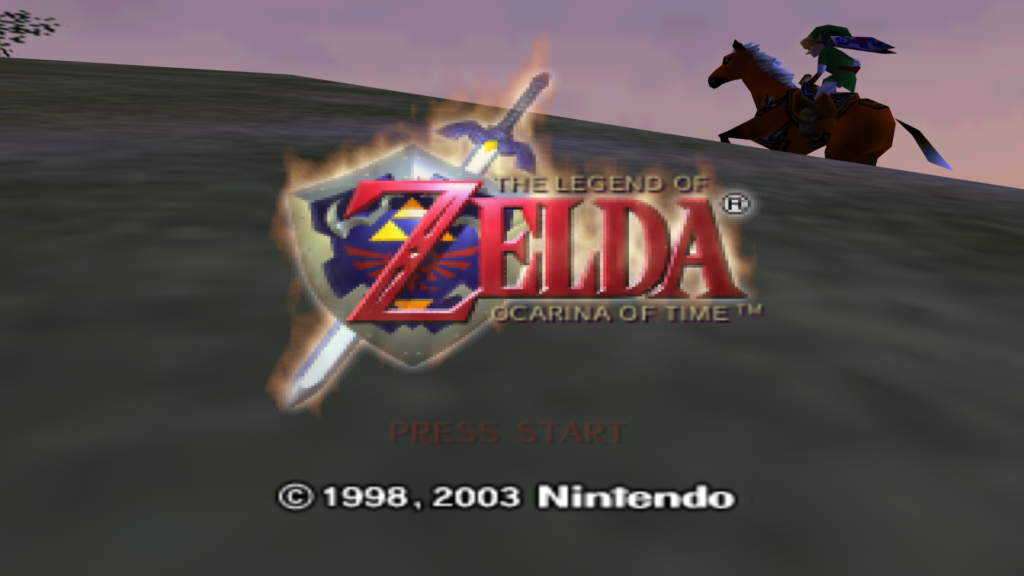
I set out on this project to exercise my critical eye and pull more out of media than I otherwise would. The Legend of Zelda: Ocarina of Time is perhaps the most critically acclaimed game of all time. My friend Billy asked me if I thought I had anything to say about this game that hadn’t already been said. At the outset of this critique I would have said no, but after combing over this game more, there is a good deal that I haven’t heard discussed.
When trying to see what works and what doesn’t in any media, it’s important to acknowledge the critic’s biases and that anything stated in a piece like this is subjective. Something which didn’t work for me might for you if you approach it differently and vice versa. Ocarina of Time is a game that I hold dear. I got the game around the age of six because I had tried its sequel The Legend of Zelda: Majora’s Mask at a friend’s house wherein you can use masks to transform into three of the Zelda races other than Hylian. I liked this mechanic so much that I badgered my family incessantly to get it for me for Christmas. I, however, mistook the game I played to be Ocarina of Time and was terribly disappointed upon playing my Christmas present and realizing there would be no transformations for me.
I stuck with the game despite this and had what is probably my most defining gaming experience. I got absolutely lost in this game’s world. The openness of Hyrule Field made me feel like an explorer, the dungeons made me feel accomplished and fearful, the characters had so much life despite looking like origami, and the rush of finding a new key item was unlike anything I had experienced in a game. Suffice to say I love this game. I love how this game shaped my expectations of games, and I consider it a stand-alone accomplishment that this game can inspire such fondness in so many to this day.
With my love of this game in consideration, I’ve done my best to look past my rose-colored glasses at what in this game is successful and what is not. Most of what I talk about will center around what in the game holds up in modern times, with some details about why certain things were done given the time of the game’s development.
Opening
The game opens with us seeing Link’s prophetic dreams about Ganondorf. We then see the Deku tree send the fairy Navi to fetch “The boy without a fairy”, referring to Link. Through this the game’s premise is quickly established. Evil has descended upon Hyrule in the form of Ganondorf and Link, a boy who is different from his people, the Kokiri, is destined to save Hyrule.
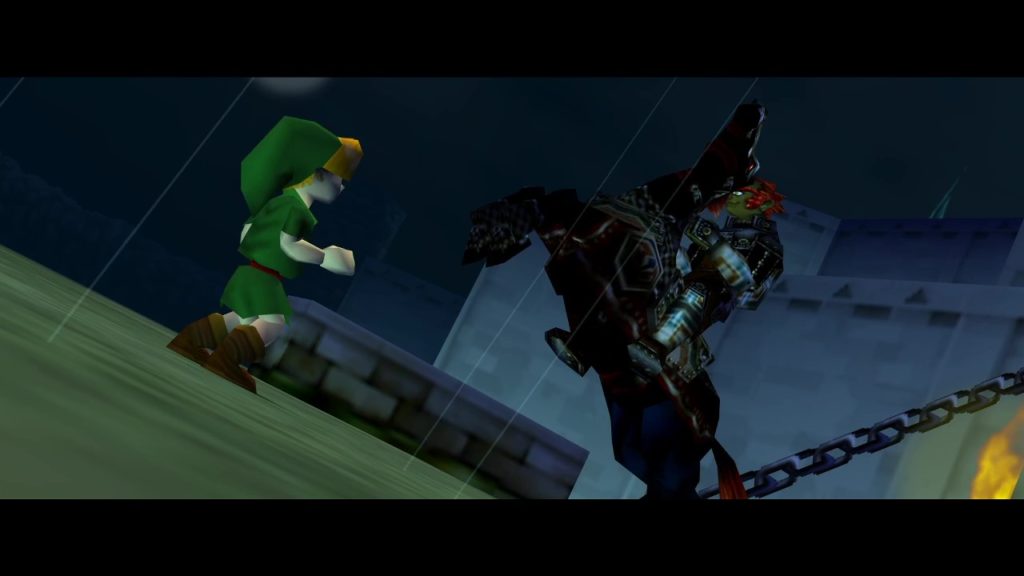
Link emerges from his house to Kokiri forest and his friend Saria. This game was the first 3D Zelda, and Link’s porch being on a balcony seems to be so as an immediate indication to the player that verticality will be important in this game.
Kokiri forest serves as an excellent tutorial location for several reasons:
You are instructed only to find the Great Deku Tree. You are given no waypoint and while the opening scene saw you flying through Kokiri forest in Navi’s perspective, it’s likely you didn’t pay too close attention to the layout, thus you are compelled to explore and talk to NPCs. Once you do find the path to the Deku tree, you are informed by Mido that you need a sword and shield if you’re to talk to him. This is an on-the-nose form of a recurring pattern in which the game blocks you from proceeding until you are properly equipped.
Acquiring the sword and shield is a rewarding process. Link initially has no abilities other than to roll and pick up rocks. Getting the sword and shield is a taste of the empowerment the player will experience over the course of the game, and it feels good to build Link into his iconic sword-and-shield-equipped self. Further, it was a good decision to make these the first items you receive as they are the most integral tools in Link’s kit and are assigned permanent buttons of their own. By giving you the sword so early, the impact of Ganon disarming you in the final fight is increased drastically because he has removed what at that point feels like part of Link, but more on that later.
The sword is only found by exploring the forest and finding a small hole you can crawl through. On the other side, you are presented with your first treacherous obstacle in the rolling boulder. Upon acquiring the sword, the game gives a text blurb about how to use it (as it does with all items) and crawling back out into the forest, the fenced path you came through is lined with signs detailing sword techniques. This is great because it provides new players an obvious resource for learning but remains optional and out of the way for experienced players. On top of this, the game’s UI clearly displays what each face button of the controller will do at the top of the screen at all times. While this slightly obscures the player’s vision, the introduction of context-sensitive commands mapped to the ‘A’ button and the ability to assign different items to the ‘C’ buttons necessitates such design.
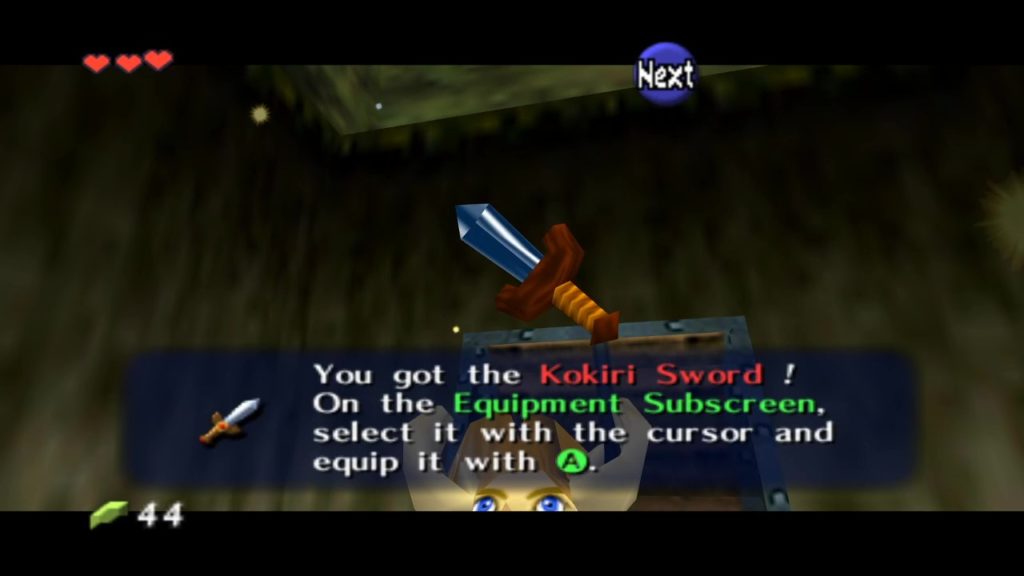
Acquiring the shield sees you collecting 40 rupees and spending them in the shop. The methods which yield the more valuable blue rupees (worth 5) are gotten by completing light platforming challenges in the forest and entering houses to find chests while green rupees (worth 1) are found in tall grass and by breaking pots. Even thoroughly exploring the outdoor area, you can only find 20-30 rupees, meaning you have to go into houses and search. While a bit tedious for repeat playthroughs, I think this sends an important message to new players of being exhaustive in your exploration of an area, so you don’t miss anything important.
One of the most novel design choices introduced in this game is the removal of a jump button. Instead players need to run off of a ledge in order to jump, something which is discouraged in most 3D games. This game came out very early in the era of 3D games and the industry standard at the time, and to a lesser extent now, was to have the ‘A’ button used to jump. The purpose of this decision is twofold: it conserves buttons on the controller for other uses and limits the player in circumstances where jumping would break a puzzle.
All-in-all, the Kokiri Forest is a safe environment which teaches the player about:
- Finding chests with key items and consumables
- Finding rupees and using shops
- Platforming and context-sensitive ‘A’ button uses
- Secrets for certain actions (blue rupee gotten by jumping across the waterfall platforms)
- Teasing paths to return to which the player isn’t equipped to traverse yet (Lost Woods shortcuts)
- Talking to NPCs and using Z-targeting
Z-targeting is a mechanic first seen in this game which has become something of a mainstay in many games with melee combat like Zelda and Dark Souls. By pressing or holding the ‘Z’ button, Navi will hover around a point of interest, enemy, or NPC and Link will orient himself facing them, allowing him to strafe around. Something which I particularly like is that pressing ‘C’-up while locked onto an enemy will see Navi giving you the enemy type’s name, some information about it, and sometimes strategies for fighting them. This helps the player understand the world better and have a name for enemies rather than “the flying pineapples in Hyrule Field”.

This is a near perfect system for melee combat in a 3D space, provided the player only needs to focus on one enemy at a time. Multiple enemies can overwhelm a player because you are limited to looking and attacking in the direction of the enemy you are locked onto. Luckily, more threatening enemies like Stalfos and Lizalfos tend to engage Link one at a time or at least hold back when Link is targeted to another of them.
Additionally, pressing the ‘Z’ button when point of interest is nearby will set the camera directly behind Link and still allow him to strafe.
The N64’s controller only had one analog stick, meaning the camera needed to either be controlled by the game itself or by using buttons. Other games from the time like Super Mario 64 had used the ‘C’ buttons to rotate the camera a fixed distance around the character, to varying success. The solution on offer here conserves the ‘C’ buttons to have items mapped to them and also gives the player more precise control over where the camera is aimed.
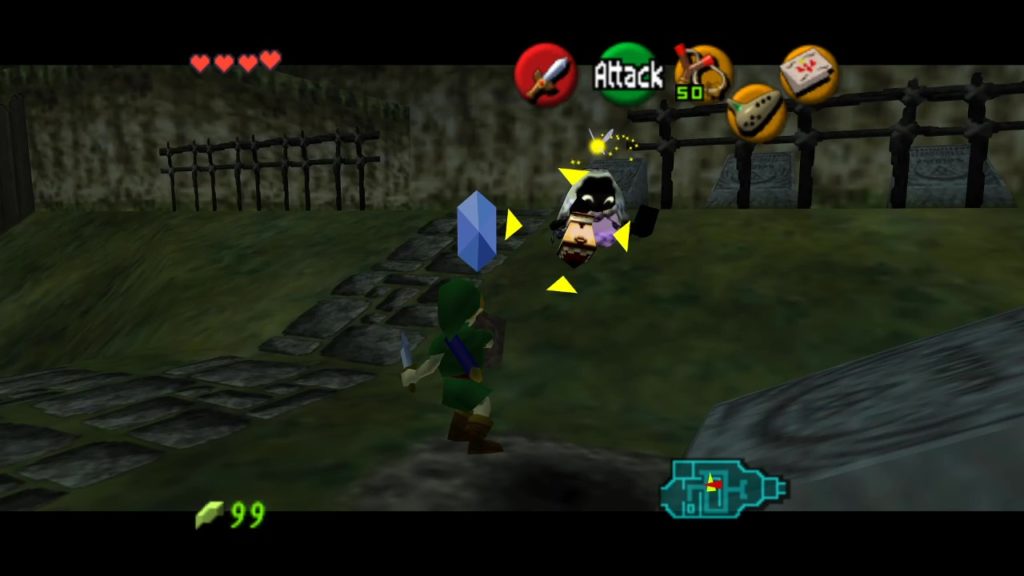
It would be misleading to describe this as a perfect or even good standalone system. It was a frequent occurrence that because I couldn’t turn the camera, Navi couldn’t figure out what I was trying to lock onto and I ended up spamming the ‘Z’ button while a Keese swooped down on me from behind. Having a dedicated analog stick for the camera as well as Z-targeting is vastly superior.
Into the Deku Tree
Once you arrive at the Deku Tree, he informs you that evil has descended upon the land and that Ganondorf has cursed him. He asks you to travel inside him and break the curse. The visual design of the Deku tree is great and the synergy of the visuals with a layout that is highly vertical (the inside of a massive tree trunk) to get the player adjusted to 3D spaces cannot be understated. I also think it was a good decision to send the player immediately into a dungeon as they are the meat of the game. Wasting no time before allowing the player to get into an integral component of the game lets them more quickly connect with the world and their purpose in it.

Immediately inside the tree there are Deku Babas, an enemy which is rooted to the ground, allowing the player the ability to back off without the enemy chasing them when first learning the combat system.
As you ascend the Deku Tree you will find the map in a chest along your path which provides you a full layout of the dungeon and displays what rooms you have and have not visited yet. Giving the map as your first item gives the player ample time to interact with it during the Deku Tree. Dungeons in this game are focused more on understanding their layout and paths rather than individual puzzles, so it’s good to allow the player time to get accustomed to using a map so early.
The key item in this dungeon is the Slingshot, an item which you aim in first-person that has puzzle-solving and combat applications. It is also the item which sees the most use for child Link. You can only leave the room in which you get this item by aiming up and shooting a ladder suspended by spider webs as the platform you jumped across on crumbles after you jump on it. This demonstrates how the player will need to be aware of ceilings and high up spaces in dungeon rooms and the game at large.
Items which use first-person aiming are perhaps the most used in this game, and for that reason it is a shame that the aiming controls are very poor. If the sensitivity had been lowered on-the-whole or if there had been some measure of look acceleration added this could have been rectified. As it is, aiming involves a lot of tapping the analog stick gently to incrementally line up shots or aiming the reticle far too wide, bringing it back, and sometimes back again. This is undoubtedly a consequence of the N64’s weak analog stick, but it’s a weakness worth mentioning.
This dungeon, and the rest of the game’s dungeons for that matter, has a heavy focus on puzzles with worldly logical solutions. Light sticks on fire and carry the flame to light torches or burn down spider webs, jump from a high place onto that spider web that bounces as you walk on it in order to break through it.
Looking retrospectively at these sorts of puzzles, their solutions are obvious, but discovering these things about the world of Ocarina on a first playthrough would be highly rewarding and require some degree of deduction. In video games it is not always evident what real-world rules a game elects to play by, so these sorts of puzzles are a good inclusion in the game, particularly early on. It encourages experimentation on the part of the player based on what they already know.
The most novel puzzle in this dungeon is the one in which a Deku Scrub tells you the number order 2-3-1 which will be useful to you later. Eventually you descend into a wide room with water and three Deku Scrubs. Unlike other Scrubs which leave their burrows and hop around when you reflect their projectiles back at them, these ones are stunned. It is never explicitly told to you, but you have to stun the Scrubs in the order told to you earlier. The only indication of this is the Scrubs being stunned and a tone indicating failure when you don’t stun them in the correct order. This puzzle helps get the player accustomed to applying things learned from NPCs at a later time.
This dungeon also sees the introduction of block-pushing puzzles. I don’t have major gripes with block-pushing puzzles other than the painfully slow speed at which Link pushes them. Overall, they are a decent, albeit not terribly interesting inclusion that can make the player think about a space more. I do like one of the block-pushing puzzles in this dungeon wherein the player pushes a block from a higher platform down to establish a shortcut between that platform and an earlier section of the dungeon. Most dungeons in the game have a shortcut like this which the player opens up, but with highly varying utility.
The final boss in the Deku Tree is Gohma, a spider… scorpion… cyclops… thing? When you enter the boss room, Gohma is on the ceiling and the fight doesn’t begin until you look up to find her large glowing eye. This eye is her weak point and if you couldn’t tell from its visual design, Navi can tell you. The fight sees you shooting her eye with your Slingshot as she crawls along the ceiling to make her fall and become vulnerable to sword hits.

This is the pattern which every boss in the game will take save for Bongo Bongo; the key item of a dungeon will be used to open up the boss so you can attack with your sword to deal damage. She has a slow melee attack when on the ground and will drop Gohma Larvae seen earlier if you allow her to cling to the ceiling without shooting her. All in all, she’s not that threatening but the dark and mysterious visual design of her boss room and creepy introduction make this introductory boss fight feel significant despite its low difficulty.
Upon defeating Gohma, you are teleported out of the Deku Tree. Up to this point, the Deku Tree and Navi have been your only sources of guidance in this world. Despite having lifted the curse, the Deku Tree withers and dies. This is done to imbue the player with purpose and set the melancholy tone of this game. It’s natural that the Deku Tree dying at the hands of Ganondorf would motivate you to seek him out and defeat him, particularly when the Deku Tree dies despite your best efforts.
Some of you may have taken issue with me calling the tone of this game melancholy just now. “Isn’t Ocarina of Time a heroic and triumphant game?” Yes, and it’s all the more melancholy for it. Though the narrative sees Link growing up into a hero that defeats Ganondorf with the aid of his friends, he also sees the collapse of the world where he made so many friends as a child. Those friends even end up adopting an ethereal existence as sages rather than one in the world of the living. Link traveled forward in time locked in the Sacred Realm for seven years of his childhood. Even entering the Door of Time is spoiled by Ganondorf’s surprise intrusion and entrance into the Sacred Realm.
Every victory is undoing something that was destroyed, and most victories come with a substantial loss. Link is an orphan who gives up any chance at a normal life from a very early age to stop an evil force.
Out in the Field
Next the player will leave Kokiri Forest, something which would kill a Kokiri, but not a Hylian. When leaving you are stopped by Saria. She tells you she always knew you’d leave one day and gives you the Fairy Ocarina as a parting gift. The Ocarina is a unique item. It serves a variety of purposes for puzzle solving, transportation, and is fun to play with in its own right as it is an instrument. This heartfelt moment helps develop the player’s connection to Saria.
Saria turns out to be one of five sages that Link unlocks the aid of after completing the adult dungeons. All of the sages are friends that Link makes as a child. Saria is the one with the most development, and interestingly has a song tied to her which solves some puzzles but also allows you to talk to her for hints, similar to Navi. We don’t get the song here, though, complaints about that later. This song is a strange inclusion when the game could just use Navi to dispense information. My only guess is that this is done to give the player another character to frequently talk to in the world or to flesh out the utility of the Ocarina. It doesn’t hurt anything but also doesn’t add much.

Exiting the forest, we are introduced to Hyrule Field. Hyrule Field is a vast area that serves as the central hub connecting the major areas of the game. It is truly massive, and I think it’s execution is rather clumsy. Its size is such to make the game experience feel grander, and I think without it being so large it would feel pretty awkward taking so little time to get between places so different as a lush forest and a desert. That said, it’s entirely too empty. Its size would be fine, but its geography is simple and there’s not much to do there, only sparse patches of tall grass, the occasional grotto, and some uninteresting enemies (pineapples). It does give the player time to decompress from the more content-saturated areas of the game and makes you feel like an explorer traveling such great distances.
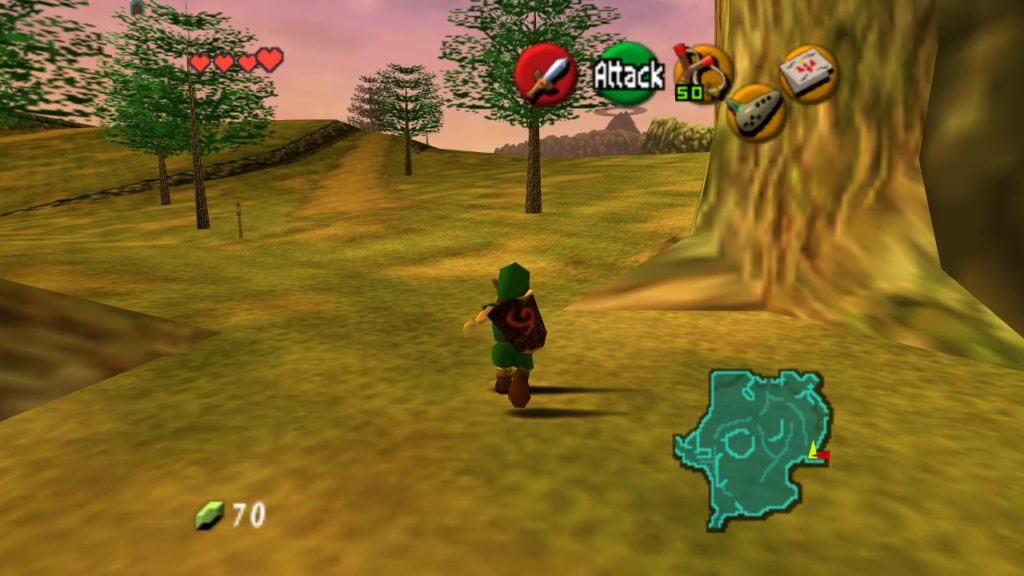
The only real piece of content in Hyrule Field is rather substantial, though. Lon Lon Ranch is in the center and hosts the side quest to obtain Epona. There is a small story about changing ownership of the ranch to accompany this quest that makes it a bit more interesting than just acquiring a horse. The inclusion of this story does a bit to populate the world Link is living in as well, and it’s good that while separate, the story here does hinge on the main plot involving Ganondorf.
Epona herself is an all-but-necessary addition to the game. She makes traversing the empty Hyrule Field a lot less tedious than it is before you have her which helps the player value and bond to her. The scale and emptiness of Hyrule Field makes me think that perhaps Nintendo liked the idea of Link riding a horse so much that Hyrule Field only exists in its form to give the player a wide-open space to ride Epona. This is a good idea but makes times in Hyrule Field without Epona quite dull.

Back to where we were, before emerging into Hyrule Field proper for the first time we meet Kaepora Gaebora, a friendly owl who shows up occasionally to guide child Link in the right direction. Here he tells us to seek out Zelda in Hyrule Castle and tells us the direction of the castle.
This is a good time to talk about the text speed in this game. The text appears at a snail’s pace and most of the time I’ve contextually figured out what the word being typed out is before it’s finished. The option to fast-forward exists for some text in the game, but rather than just immediately completing the current page, it will fast-forward to the end of the conversation. This decision baffles me. Even if the text moved more quickly by default, players who can’t read as quickly don’t have to press ‘A’ to proceed to the next page of text until they’re ready. The reason I bring this up now is that after Kaepora finishes his spiel, he asks you if you got all of what he said, and the default conversation option is “No”. Now, if you’re like me, you’ve been spamming the ‘A’ button to get through this slog as quickly as possible, and then you accidentally ask Kaepora to hear it all again. Terrible design.

Hyrule Castle
You then start off for the castle, but when you’re nearly there for the first time, the sun sets and the bridge is drawn up right in front of you even if you went straight there. Besides using a speedrunning trick of “backwalking” to move quickly whereby you Z-target and walk straight backwards toward your destination, there isn’t a way for the player to reach Hyrule Castle before night, and a new player would never know to do that. This means that the player has to wait and fight the Stalchildren which spawn at night until daytime.
While this poor timing introduces the player to the day/night system, one which I think benefits the game a lot, I don’t think that this was the best way to do so. I think extending the first day the player enters Hyrule Field would have been nice, and then the player could have experienced the day/night system at some other time when they wouldn’t have to just wait around.
The day/night system adds life to the game in an efficient manner. Rather than having different areas for events and NPCs, the developers could just make some events and NPCs only show up at particular times of day. This helps Hyrule be more believable and gets more mileage out of the different locations.

Once you do make it inside of the castle town, you’re greeted with a bustling marketplace with cheery music and many NPCs to talk to. Over the course of the game, Hyrule Town does wonders for the atmosphere and worldbuilding; it is initially the most populous and cheery location in the game and strikes the player hard with solemnity when you see its dilapidated state seven years later. Approaching the castle, you are no longer greeted with the familiar location text reading “Hyrule Castle”, now “Ganon’s Castle”. There is a point I have to bring up that I heard mentioned by Matthewmatosis too important not to mention:
“In most action-adventure style games that revolve around saving the world, you’re given some idyllic place that needs protection or a post-apocalyptic world where the struggle of the people compels you to try and help them. Either of these scenarios can only be so effective because we’re left wondering what it is we’re trying to prevent or what it is we’re trying to restore. As soon as you walk into Hyrule Town seven years on, Ocarina of Time has answered both of these questions; you have an immediate comparison in your mind of what Hyrule should look like and what it does look like now.”

This supplements the melancholy tone of the story, particularly because this is the first area you see after becoming an adult. It’s one of the most sobering moments in any video game I’ve ever played. When you’re a child, most of the issues you’re presented with aren’t that serious, and the childhood portion of the game is filled with silly moments like your engagement to Ruto and inconsequential tasks like corralling Cuccos. Once you’re an adult, things are serious. The world is in a bleak state and depending on you to set things right; Kokiri Forest is overrun with monsters, the Gorons are locked up to be fed to a dragon, the Zoras are frozen in ice, etc.

Once you approach the castle, you meet Malon who tells you her father fell asleep delivering milk to the castle and asks you to take a Cucco egg which will hatch in the morning into a Cucco used to wake him up. You then have to sneak past the guards on the castle grounds. This is the first of a few light stealth sections of the game where Link has to avoid detection. These stealth sections are pretty basic but help add some variety to the gameplay.
You eventually get inside and Zelda sets the player on their primary quest to gather all of the spiritual stones from the childhood dungeons in order to enter the Door of Time and teaches us Zelda’s Lullaby, the most widely applied puzzle-solving song. I have mixed feelings about this song. It is a good idea to have the Ocarina used to solve puzzles, but any time the song is used there is a Triforce insignia and/or something you can check referring to the royal family. Once you’ve solved the first instance of this song being used, you’ve solved them all with no further thought. If some strategy had been used to make times where you need the song more obscure, like in the instance of Darunia’s door where you hear from a Goron that he’s waiting for a messenger from the Royal Family then this would have been better.
Introducing the player to Zelda so early was good because she is our primary ally through the entire game (even though you don’t know it for the adult portion) and the character with the plan for bringing down Ganondorf. This makes the player feel weakened when we see her flight from Hyrule Castle at the end of the childhood section and have to proceed alone.
In the Belly of the Whale
The two remaining childhood dungeons are pretty good. They benefit most from their unique visual designs and your motivation for entering them. Dodongo’s Cavern appears to be the inside of some great beast’s skeleton with a giant ribcage framing the main room and Jabu-Jabu’s Belly is literally inside of a whale. You enter these dungeons to get the spiritual stones, but also for more noble purposes of opening the Gorons’ food supply and rescuing Princess Ruto. These actions result in sworn brotherhood with Darunia and engagement to Ruto, things which are never consequential aside from Darunia naming his son after the player, but which do a little to strengthen our attachment to the characters.
The paths to these dungeons are a bit too obtuse for their own good, however. Entering Dodongo’s cavern sees us playing Saria’s Song for Darunia to lift his bad mood, a consequence of the food shortage. The issues with this are that there is no indication that a song is needed here and the player likely doesn’t have Saria’s song. To get the song, you need to GO BACK TO THE FOREST. I have no earthly idea other than padding out the length of the childhood portion why this would be the solution. Navi hints that we should ask Saria what she thinks about what we’re doing after we meet Zelda, nudging us toward Kokiri Forest, but this still makes very little sense.
To get into Jabu-Jabu’s belly, we speak to King Zora who tells us that his daughter Ruto has disappeared. By talking to every Zora in Zora’s domain we get some clues about Jabu-Jabu and play a mini game which rewards us with the Silver Scale, giving us an enhanced ability to dive underwater. Using this we can access the shortcut to Lake Hylia. Emerging into Lake Hylia, Navi flies toward a message in a bottle at the bottom of the lake to draw our attention there. The Silver Scale is necessary to get this.
I’ve heard many people complain that the way to enter into Jabu-Jabu is too hard to figure out. You need to present him with a fish. Not only is this a semi-logical conclusion provided you know that you can bottle fish (you can see them in the store), but one of the Zoras even tells you that offering a fish to Jabu-Jabu is rumored to “make you happy”. I find that the route into Jabu-Jabu is much more obvious than getting and playing Saria’s Song for Darunia, but neither adds much to the experience.
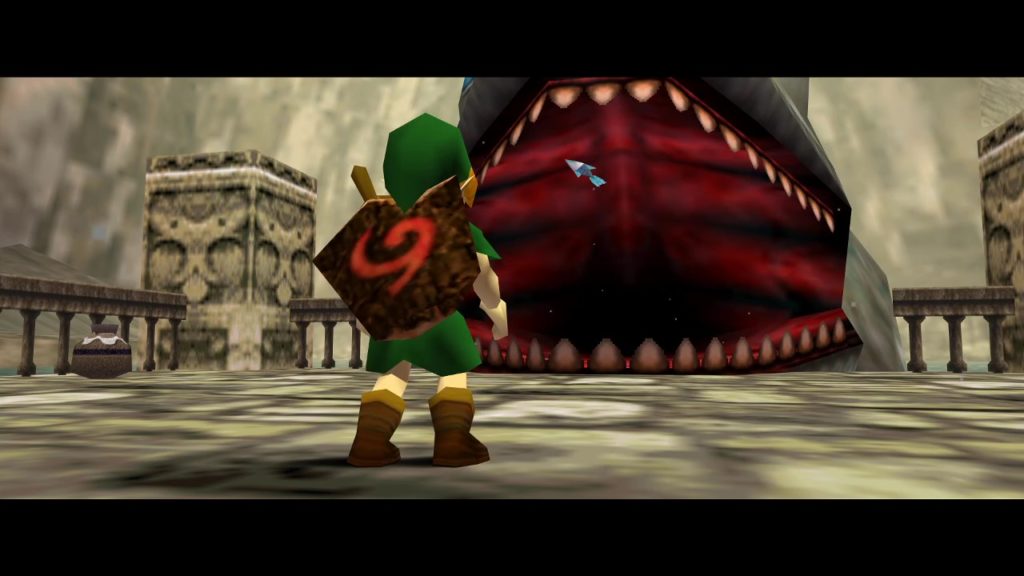
All of the childhood dungeons, unlike the adult dungeons, do not have small keys, meaning that progress down paths have to be gated by other means, usually more creatively. In Dodongo’s Cavern, the player has just been given the Goron Bracelet by Darunia, allowing them to use Bomb Flowers planted in set locations, but certain destructible walls do not have Bomb Flowers nearby. Part of the way through the dungeon you get the key item, the Bomb Bag. I like this because the dungeon relies on the what is essentially same item all of the way through but expands your capability with it.
In Jabu-Jabu, you find Ruto, and have to carry her through the dungeon as a prop used to open doors locked by heavy buttons or buttons which need to stay held down. This is a unique way to execute an escort mechanic and makes her feel less like a burden than she otherwise might. Paths are also blocked by parasitic tentacles. Destroying these requires you to take note of their color and destroy an extension of them in other rooms using the boomerang. The rooms which you destroy the respective tentacles are not far from the paths they block, so as to not confuse the player too much, and I think this is good as it is still fairly early in the game.
These two childhood dungeons also introduce mini-bosses to the dungeon formula in Ocarina of Time. In Dodongo’s Cavern there are two 2-on-1 fights with Lizalfos which are agile dagger-wielding enemies and in Jabu-Jabu’s belly you fight a Big Octo. The fights with the Lizalfos are interesting as they take place on platforms above lava which adds some tension to the fight, however limited. The fight with the Octo is decently unique due to its claustrophobic experience of being on a track with the Big Octo and uses the dungeon’s key item.
The boss of Dodongo’s Cavern is very simple once you’ve figured out what to do but descending into a lava filled room and being crept up on by a dinosaur is a nice enough setpiece. You throw a Bomb in King Dodongo’s mouth to stun him before attacking with the sword, nothing special. The boss fight of Jabu-Jabu’s belly is one of the best in the entire game. Barinade has several phases and requires you to continually move while tossing the boomerang as well as switch targets between it and the multiple jellyfish attached to its body. There’s a bit of strategy and execution involved beyond just using the dungeon item which is nice to see. These dungeons are satisfying to complete, but with little challenge in the way of puzzle-solving.
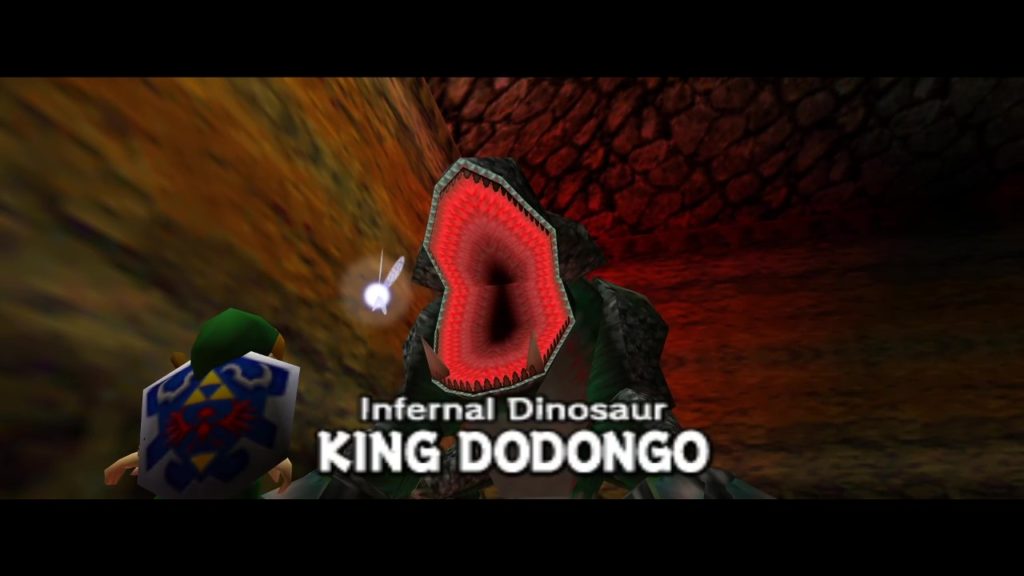
Growing Up
Earning all three Spiritual Stones is a triumphant moment in the game. Upon reaching Hyrule Castle we see Zelda and Impa flee the castle. Zelda tosses the Ocarina of Time back for us as they leave so we can open the Door of Time. Ganondorf emerges from the castle shortly after them, echoing the image of him we saw in our dream. He asks us which way they headed then promptly blasts Link with magic for giving no answer. This instance continues the theme of every victory being soured by some loss. The player has assembled all of the pieces they needed to aid Zelda in taking down Ganondorf but now she’s gone.
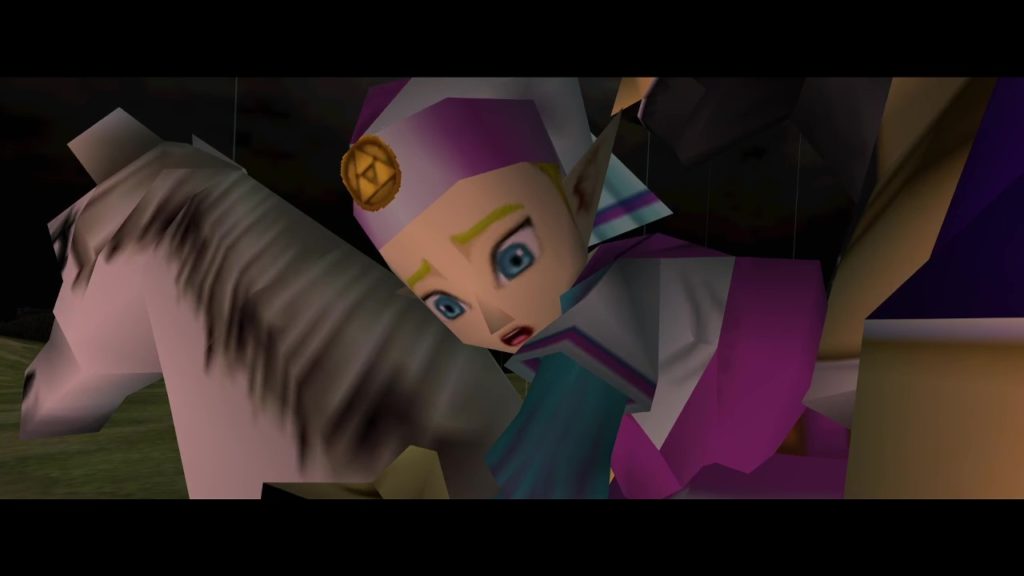
After Ganondorf rides off we retrieve the Ocarina of Time, imbued with a memory in which Zelda teaches us the Song of Time to open the door. The song is also used to move blocks with the Door of Time’s insignia on them, nothing major. We then proceed into the temple, set the Spiritual Stones on the pedestal, and play the Song of Time to open the door. Once it’s open, we see that Ganondorf has followed us into the temple and we just granted him access to the Sacred Realm; an “all is lost” moment compounded by what we see when leaving the temple as an adult.
This is an interesting moment in the game because the player has just been achieved what they were set out to do, have been given the Master Sword, and turned into a more powerful version of Link, but Ganondorf was able to spoil what should have been a victory, and it’s only made worse after seeing Hyrule Town’s dire state.
After meeting Rauru, the sage of light, he informs you that you’ve been sealed inside the Sacred Realm for seven years. You then depart, but not before you meet Shiek who has been waiting for you inside the temple. Shiek serves as your only real companion in adulthood and seems to show up conveniently outside of every dungeon to impart some wisdom and teach you the song used to teleport there.

Sheik is a strong character for the game. She doesn’t show up often enough to invade on the sense of loneliness the player is supposed to have in the adult portion. This has the added benefit of making her more mysterious so that the payoff of her reveal as Zelda carries more weight. Characters in the game even refer to Sheik as “him” to throw you off any potential trail to discovering her identity before you’re supposed to.
While on the topic of twists, I think that the game could have used Link becoming an adult as an empowering surprise. It even seems that this might have initially been the intention, as when you’re speaking to Rauru you can’t see Link until he tells you not to be alarmed but to look at yourself whereupon we see adult Link for the first time. Perhaps Nintendo felt compelled to advertise the child/adult mechanic of the game as its “thing” , but it could have made for an excellent surprise to the player if they hadn’t.
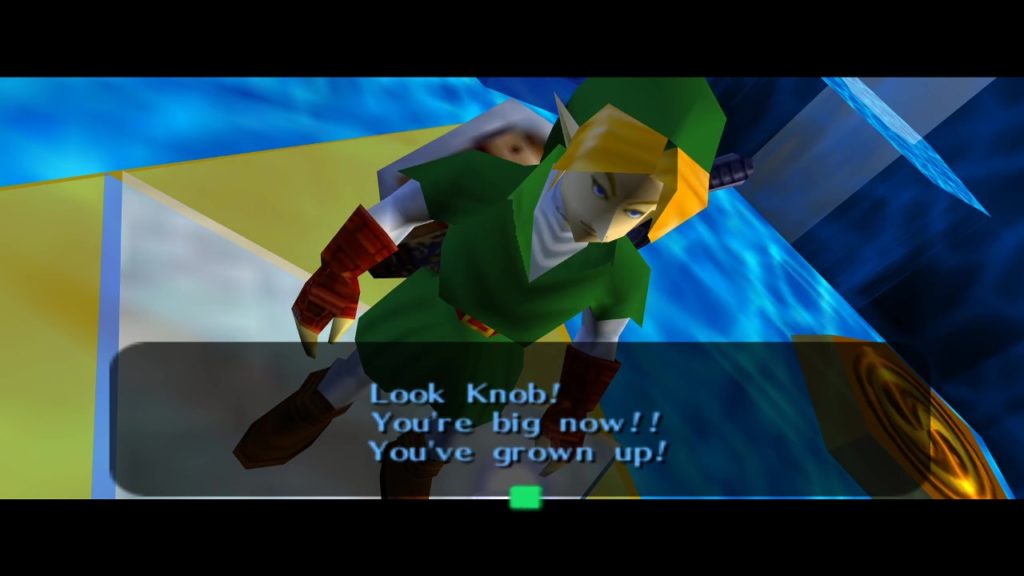
Time Trekking
The time travel element is something I wish had been more consequential in the game. It is certainly good for the plot of the game, but the things each Link can do that the other cannot is very limited. Child Link can crawl through holes, use the Hylian shield like a turtle, and use items that adult Link arbitrarily can’t. Adult Link can wield the Hylian shield normally as well as the Mirror Shield, ride Epona, wear other tunics, grab some higher ledges, and use items and equipment that child Link can’t (some make more sense like the Megaton Hammer or Biggoron Sword). That list may seem long, but most of the things listed are arbitrary or have simple, passive effects.
There is only one, maybe two dungeons which use time travel in any capacity. The primary dungeon that uses it is the Spirit Temple, which sees one half of the dungeon devoted and accessible by child Link. He completes his half to get the Silver Gauntlets used by adult Link to enter the dungeon. I think this could have been much more interesting had the two sections overlapped and interacted more. As it stands, it’s essentially two separate small dungeons accessed in the same location. The obvious reason the two halves do not interact more is that time travel requires a lengthy process of returning to the Temple of Time to switch between the two.
This could’ve been rectified by allowing some method of “in the field” swapping between the two, perhaps with the Song of Time, but one could argue that the plot doesn’t allow for this. I would say that this was also done because the difference between the two Links is largely inconsequential and frequent swapping would just feel tedious. As it stands, I think that the time travel element is something that had a lot of gameplay potential that was mostly included for plot.
The second dungeon that you might say involves time travel is the Shadow Dungeon. In order to proceed through it you need the Lens of Truth acquired in the childhood mini-dungeon, Bottom of the Well. This is in some way the same thing as the Spirit Temple with a bit more walking between the different dungeon entrances. A mini-dungeon experience for child Link gets an item required for adult Link to enter the dungeon proper.
I think if entrance into any dungeon makes no sense it is the Bottom of the Well. When you arrive in Kakariko Village as adult Link, you and Sheik are confronted with a dark spirit escaping the well. Sheik teaches you the song to reach the Shadow Temple. Upon entering, a door tells you that the shadow will yield only to those wielding the Eye of Truth, referring to the Lens of Truth. There are hints about this being in the Bottom of the Well, from the evil sealed down there, the ladder descending the well, and an old man in Kakariko talking about someone who had the Lens living where the well now stands.
The problem is getting into the well. You’d be forgiven for thinking that perhaps you just didn’t have the proper item to enter the well which is drained but blocked by cement as an adult. The route to entering it is to learn the Song of Storms from the man inside the windmill who is irate that a kid taught him the song seven years ago, then go back in time and play it for him as a kid which drains the well, something which logically makes no sense, given that he teaches you the song but you also teach it to him. There is no reasonable explanation for why a song which causes storms and the windmill to spin faster should drain a well. On top of this, unless you’ve returned to the Temple of Time for some reason, you may have no clue that you can even revert to childhood at all as the game never tells you this otherwise.
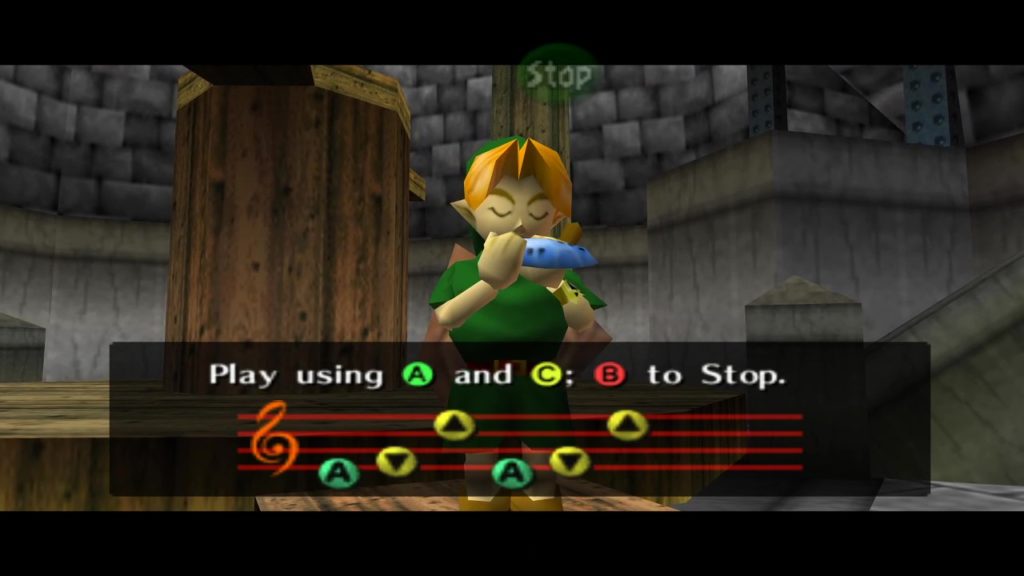
The Bottom of the Well itself isn’t too interesting. It mostly serves as an introductory space for the Lens of Truth. Interestingly enough, this is the only place in the game where child Link uses small keys apart from the Spirit Temple and also the only place in the entire game where you have a decision about where to spend a small key.
I’ve strayed a bit from where we were, but I think it was necessary to talk thoroughly about these two mini-dungeons here as they are the only essential returns to childhood.
Dungeoneering
Back to when the player first meets Sheik, she tells us vague locations of the five temples and that in order to proceed that we’ll need another skill that we’ll find in Kakariko Village, referring to the Hookshot. The Hookshot is needed for every adult dungeon except the Fire Temple and even has optional uses there. It is the most used item in the game, rivaled only by the Ocarina. It’s good then that it is fun to use. It feels almost as integral to Link’s kit as the sword and shield once you get it, expanding his platforming ability and providing a limited ranged attack/stun.

Once you have the Hookshot from Dampé’s grave, the path forward as an adult is always clear with the exception of the Lens of Truth and perhaps the Iron Boots. The five dungeons save for the Spirit Temple are all in locations visited as a child or extensions of those locations. There are variations in the order you can visit the dungeons gated either by necessary items or needing to have completed other dungeons but the order the game will push you toward via Navi is Forest-Fire-Water-Shadow-Spirit.
The adult dungeons all achieve success in atmosphere and visual design, but vary greatly in quality of layout, progression, and difficulty. Something which surprised me in playing through this game again with more intention is that individual puzzles in this game are very straightforward.
Most puzzles have single-step solutions that are fairly obvious. The challenge is usually either in the execution of a platforming element, timing, or how multiple rooms in a dungeon interact. It’s a little disappointing to revisit for that reason, particularly because six, perhaps seven of the eight dungeons have limited or nonexistent elements of multi-room interactions (only Forest and Water have such elements to a substantial degree).
The Forest Temple will see you returning to Kokiri Forest. As you enter you see that the whimsical forest you lived in as a child is now overrun with monsters and the Kokiri have been shut up indoors because of it. They don’t even remember who Link is because they never grow old and he did. Mido even told people that Link was the cause of the Deku Tree’s death. We proceed through the Lost Woods and Sacred Meadow to the Forest Temple entrance where Saria taught us her song.
Returning to places visited as a child to see them barren or in some other dire state occurs with every dungeon save for (once again) the Spirit Temple. Goron City is empty, Zora’s Domain is a frozen ghost town, and Kakariko Village is burning when you go there before the Shadow Temple. This effect is good for the same reason as discussed above with Hyrule Town, and it feels like you have a true impact on the world to restore these places to their former state (except Zora’s Domain which remains frozen due to the Biggoron Sword quest).
Back to the Forest Temple, there is a heavy focus on illusion in its visual and dungeon design. There’s a foggy visual effect about the dungeon and many of the rooms are symmetrical to another nearby to mix up the player’s sense of where they are or where they came from. The dungeon even has a cool mechanic where eye switches are shot to twist or untwist hallways leading to rooms which allow access to different places or chests depending on their orientation. There are even two such switches and hallways to further the player’s confusion as to which one leads where. The concept of activating something in one room which alters the layout of the dungeon as a whole or other rooms is a good one that wasn’t done enough in Ocarina of Time.
The objective of this dungeon is to return the flames of four Poes which were seen in the main room upon entrance to their torches, activating an elevator to the boss room entrance. When you find the Poes you have to lure them out then fight them to restore their flames. Two of these Poes are in symmetrical rooms leading to and from the room with the Stalfos fight where we get this dungeon’s key item, the Bow. Another Poe is found later in the dungeon where you assemble a literal block puzzle with its face on it and the final is found and fought upon returning to the main room.

This collection gimmick is a nice additional reward for the player as they progress through the dungeon without supplying them items or keys. This gimmick is seen in altered form in the Fire Temple when freeing Gorons. The act of progressing and opening the dungeon is rewarding itself, and this adds to that reward, if only superficially.
The Bow functions much the same as the Slingshot but more powerful and with elemental variants that use magic power (fire, ice, and light). It has the added benefit of being able to be fired through torches to melt ice and burn webs, later made obsolete by fire arrows. The function of the Bow is still mostly limited to hitting eye switches and combat, with the additional use in this dungeon to lure Poes out of their paintings.
The boss of this dungeon is Phantom Ganon. Entering the boss room and seeing Ganondorf present is a pretty shocking moment for the player. The fight itself is good and keeps with this dungeon’s theme of illusion. Phantom Ganon rides his horse in and out of paintings and a slightly different colored clone of him can be seen appearing in different paintings to distract the player. After shooting him several times with the Bow, the energy tennis phase of the fight starts.
Phantom Ganon will successively hit the energy ball back at Link more times based on his health; this is a simple way the fight ramps up in difficulty and tension without changing anything about the boss’ moveset. Don’t take this to mean the fight is difficult. No boss fight in the game is particularly difficult, and most obviously telegraph the intended strategies for the player to use.
Weak Links
The next temple is Fire and sees our introduction to tunics with passive effects in the Goron Tunic, used to survive in hot places. We either get the tunic for free by stopping the rolling Goron Darunia named after us or by buying it from the Goron City Shop. Both the Goron and Zora tunics can be gotten for free and I think it might have been better had the player been forced to buy them as rupees don’t see a lot of use in the game. Additionally, it is nice to have some simple cosmetic variance for Link even if the function of the tunic isn’t too interesting.
I don’t intend to talk at length about every dungeon, as this critique is quite long already. The Fire and Shadow Temples are the two weakest, even if Fire is better than Shadow. Both dungeons have relatively weak key items with limited applications. The Hover Boots only ever serve one purpose as an extended jump. The Megaton Hammer would be a good item if it were better in combat, but it is just too slow and too limited in range. It’s a good idea to have it break un-bombable rocks and its use to activate rusty switches is decent if not too interesting. My disappointment with the Megaton Hammer has less to do with what it can do and more with its limitation in combat, as it could have been a fun alternative to using the sword.
The Fire Temple has a nice ancient aesthetic and the maze-like rooms add a bit to confuse the player about their direction, but the paths forward through both are almost always clear so long as you check every room accessible to you. The Shadow Temple has a fun use of the Hover Boots in its corridors with fans, but not much else. The puzzles in the Shadow Temple are mostly limited to silver rupee collection or throwing a Bomb into a container. If ever something in the Shadow Temple is unclear, its solution is made immediately apparent by turning on the Lens of Truth. Almost all the way through the Shadow Temple you have a locked door in front of you, and an adjacent room where you get the key for it.

It’s hard to say how important this trait of the Shadow Temple is, though it feels less like you’re finding your way and more like you’re being led along a trail of puzzles. As pointed out in Mark Brown’s video about Ocarina of Time’s dungeon design, every dungeon in this game only ever gives you one place to spend a small key a time, even if you can acquire multiple. Collecting multiple keys and having multiple routes is then, to some degree, just an illusion of complexity in a dungeon or a method for avoiding backtracking. The real strength of dungeons in this game come from them barring progress ways other than with small keys, like when the key item can be used in rooms already visited in the dungeon after you get it or some element changing paths of the dungeon.
It is necessary to mention that the Shadow Temple has the best boss in the game, Bongo Bongo, who can be fairly challenging. The boss room is interesting, being a giant drum, and Bongo Bongo is a set of disembodied hands and an invisible bursted neck(???) requiring use of Lens of Truth in tandem with the Bow to shoot his eye(???). As the fight goes on, he beats the drum, bouncing the player off of the drum. This adds a challenge of positioning and movement when avoiding attacks and getting your own attacks in. It’s also the only boss fight in the game beside Gohma that doesn’t depend solely on the dungeon’s key item to defeat.
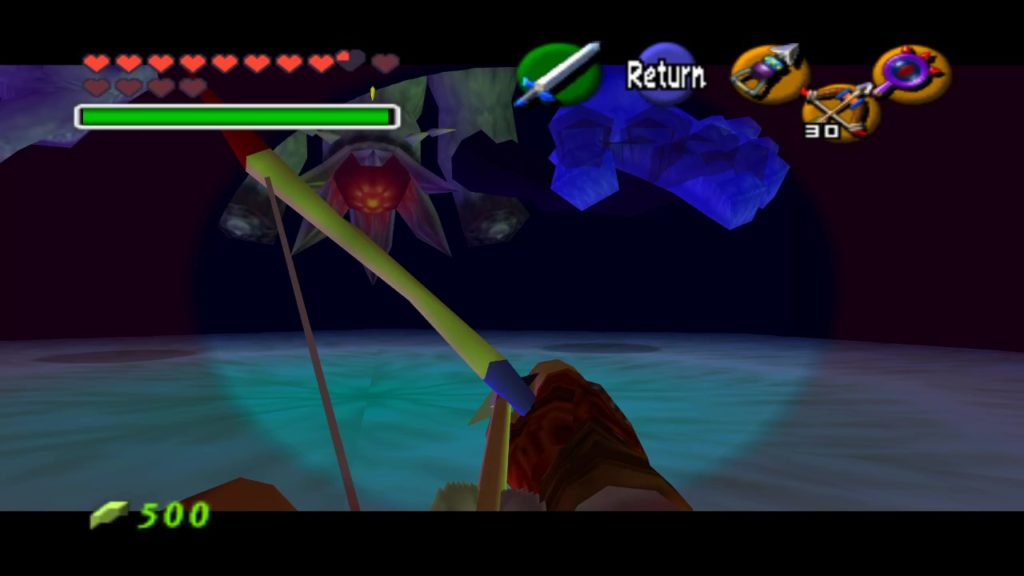
Dungeons as Puzzle Boxes
The dungeon which excels in changing paths and recontextualizing rooms is the Water Temple which has many floors and rooms with variable accessibility depending on three water levels you can set the dungeon to. Replaying it, I will say that it is not nearly as confusing as I had thought when I played as a kid, and you need only change the water level a few times, but there were moments when I had to actually stop and think about the consequences of adjusting the water level in the dungeon, something which only ever occurred for me otherwise in the Forest Temple. The water level is adjusted from three different places in the dungeon, but the switches for the two upper levels are only accessible when the water is at a certain level.
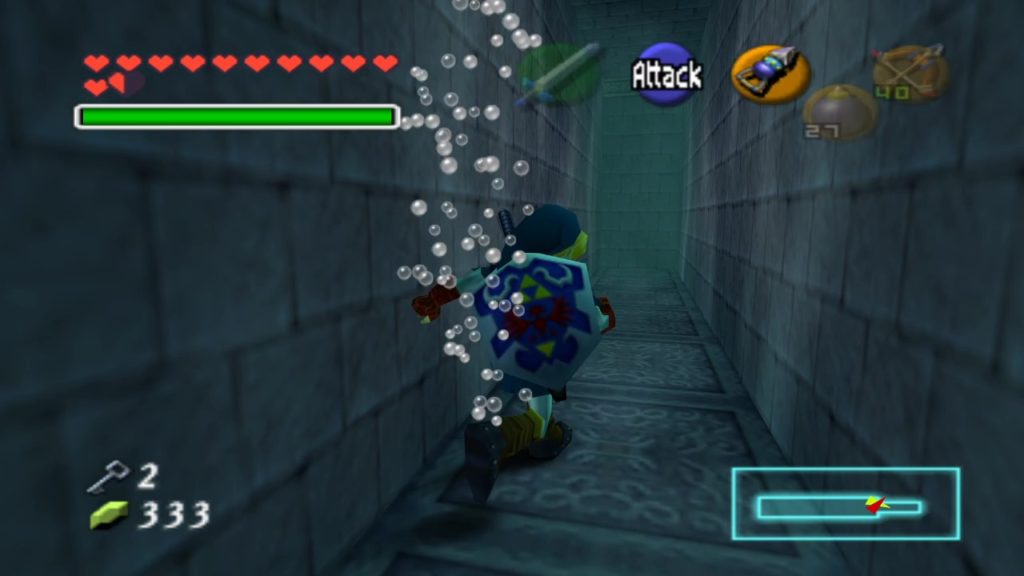
This mechanic means that the player needs to plan for what they intend to do next and spreads the challenge of solving a puzzle across the whole dungeon. If there is an unsearched room, the player has to determine which water level is needed to access that room, travel to change it, and depending on what they may find in that room, set the water level to something else and search for an alternate route to that room to. It’s nothing approximating rocket science, but it is a challenge, and particularly so for someone new to Zelda dungeons.
The weakest part of this dungeon is the mini-boss fight. Dark Link is a great idea with fantastic presentation but this fight is a terrible combat experience. As you enter the room of the fight, you are in an apparently boundless room with a reflective water floor and a small island with a tree in the center and a door on the far side. Initially it seems there is nothing in this room, so you approach the far door. I remember being a kid and entering this room for the first time. When I reached the door and looked back, I could just barely make out something standing completely still in front of the tree on my small CRT TV. I was terrified when I finally realized there was something there.

The fight with Dark Link sees him imitating your sword attacks so that none hit him except for a certain combo of swings. Alternatively, the player can use the Biggoron Sword, Megaton Hammer, or Din’s Fire to cheese the fight. Dark Link is simultaneously the hardest and easiest mini-boss in the game, but not for good reason.
The Water Temple also has us using the second alternate tunic, the Zora Tunic, which allows us to breathe under water in coordination with the Iron Boots. It wouldn’t be a critique of Ocarina of Time if I didn’t talk about the hemorrhoid that is swapping the Iron Boots off and on. The Iron Boots fall under the category of equipment in Ocarina of Time. Rather than being assigned a ‘C’ button like items, equipment can only be swapped out from the pause screen, which has an animation on startup and when switching subscreens. Link is unable to swim freely through the water, even with the tunic, and thus relies on equipping the Iron Boots to descend and then removing them to ascend. This amounts to a painful slog wherein you may equip and unequip the boots several times in the span of a few minutes to progress through a path in the dungeon. This problem is exacerbated by the fact that players, particularly new ones, will likely be retracing their steps in this dungeon over and over to figure out how they need to manipulate the water level and where they need to go.
The key item in the Water Temple is the Longshot. This item simply extends the range of the Hookshot. Much like the progression from using Bomb Flowers to having the actual Bomb Bag, this expands the capability of an item we already have. One could argue that this is weak and that a unique item would be better, but I think baiting the player with something they know how to solve but for some reason can’t, in this case out of range Hookshot targets, is an interesting mix on the formula and having your existing equipment upgraded can help it feel like Link is being made stronger rather than more versatile. The Longshot is also good because it has uses outside of this dungeon that the Hookshot couldn’t manage such as crossing the Gerudo Valley bridge or the upper level of the windmill in Kakariko Village.
(Mini-)Dungeoneering
The Water Temple and Spirit Temple are both gated behind a mini-dungeon like the Shadow Temple. The Ice Cavern must be completed to obtain the Iron Boots and Blue Fire to unfreeze King Zora or the Zora’s Domain shop for the Zora Tunic. The Ice Cavern is our introduction to puzzles wherein silver rupees are hidden throughout a room that must be collected to open a door; these can be good if done well and potentially give the player several problems to solve in a single room. This mini-dungeon also expands the concept of block-pushing puzzles in combination with its slippery ice floors. The player has to plan a full route for a block before pushing it because it will slide until it falls off of the floor or hits an obstacle, requiring the player to determine a safe combination of pushes to get the block where they want it. These are quite satisfying to complete and actually make block-pushing fun.
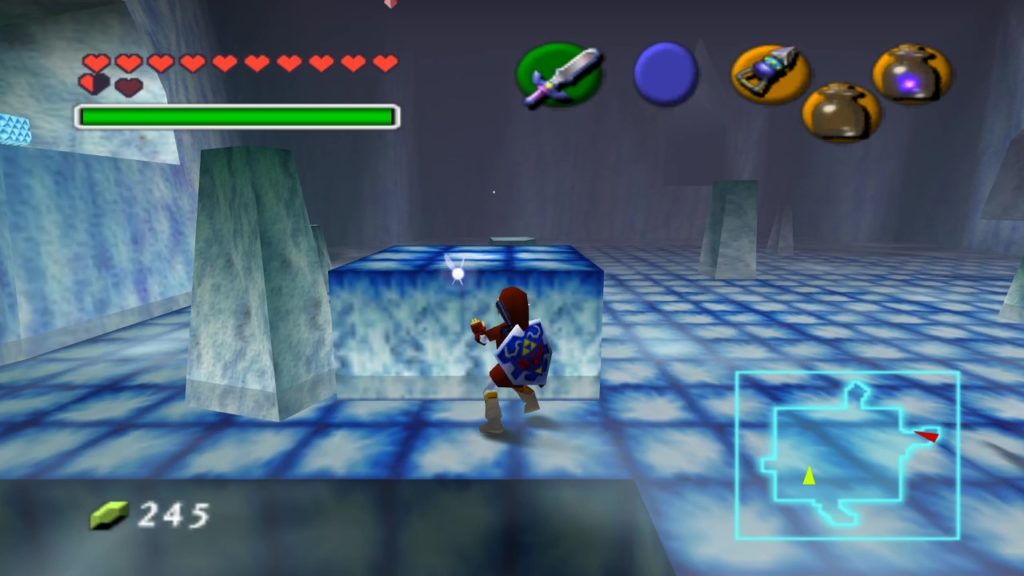
The mini-dungeon gating the Spirit Temple is Gerudo Fortress in the desert. This is the first and only area of the game which was completely inaccessible as child Link. The mini-dungeon sees you freeing four carpenters imprisoned in the fortress’ labyrinthian layout. Each carpenter is freed by fighting a Gerudo scimitar-wielder to get a key for their cell.
The primary element of the mini-dungeon is an evolution of the stealth section when entering Hyrule Castle as a child. The Gerudo guards will not fight you, rather throw you into holding (for some reason with all of your weapons and gear, but oh well) that you escape from by Hookshotting up to the high window to escape. The Gerudo can be stunned with the Hookshot or knocked out using arrows. This is good, as Link should be better equipped for something like this now that he’s stronger, and I think that using stealth sections at the game’s beginning and end was a good choice and avoids them feeling overused. The challenge of avoiding Gerudo here can be more difficult than before as they patrol tight corridors.

Finishing this mini-dungeon grants the player unfettered access to the Fortress and the Haunted Wasteland path to the Spirit Temple.
Across the Desert
The Spirit Temple’s time travel element is interesting and having the first section of the dungeon accessible by each Link as mirror images of one another is a nice touch. The Spirit Temple is the strongest dungeon in the game in terms of individual puzzles. Many of the rooms have multiple problems to be solved before proceeding, and the addition of light for problem solving is a good way to freshen puzzle solving which has used mostly the same elements through the preceding dungeons.
My favorite individual puzzle in the entire game is in this dungeon. The enemy type Anubis does not attack you unless you attack it, but rather imitates your movement. They are weak to fire, and in the child section of the Spirit Temple, you are introduced to them in a room with precarious footing and an active ring of fire. Your goal is to travers the room to get the Anubis to the ring of fire to kill it. My favorite puzzle is an expansion of this idea.
In a room with precarious footing you are presented with three Anubis? Anubises? Anyway, they are all in different locations and there is a switch in the room that activates a temporary ring of fire. The solution to the puzzle requires that you figure out what position in the room you need to get to after hitting the switch for each Anubis to burn. This puzzle actually took me a good amount of time to figure out. It’s a nice puzzle because it’s not immediately obvious to solve but is retrospectively very simple. Sadly, though, puzzles with Anubis can be cheesed by using Fire Arrows or Din’s Fire to avoid having to do any puzzle solving. This is very sad, particularly because they’re one of the most interesting inclusions in the game and some players will never see the puzzles as intended.

This dungeon also sees the inclusion of trap chests which don’t do much damage to the player, but aid in making the dungeon feel like a hostile environment. Another instance of the dungeon baiting you into interacting with something you think is safe is present in the adult portion. In the center room with the statue, you push an Armos statue off a ledge onto a switch below as a child. When you return as an adult and reach the opposite side of the room that also has an Armos statue, this time it is a living Armos. It’s a nice little detail.
The Spirit Temple has the best mini-boss in the game as well, the Iron Knuckle. The Iron Knuckle is the most threatening non-boss enemy in the game, dealing four hearts of damage upon landing an attack. What’s more, when you’ve damaged an Iron Knuckle enough, they shed some of their armor and begin to move more quickly. They’re a nice inclusion as many of the enemies in the game deal very low damage. I think putting them so near to the end of the game was a good decision to continually ramp up the challenge facing the player.

The Mirror Shield and the Silver Gauntlets are the key items (equipment) gotten in this dungeon. The Silver Gauntlets are uninteresting but inoffensive only because you receive two key items in this dungeon. They open up the adult portion of the dungeon and allow the player to lift indestructible rocks elsewhere in the world. The Mirror Shield is a creative idea and expands the already interesting premise of light puzzles. This item’s best use in the final puzzle of the dungeon wherein you traverse several rooms turning mirrors to get light from one room through several other rooms and down an elevator where you use the shield to illuminate the center room statue, opening the path to the boss.
Before fighting Koume and Kotake they present you with another Iron Knuckle to defeat. Upon defeating it, it is revealed to be Nabooru. I think Nabooru’s implementation was unique. Like all of the other sages, she is introduced to child Link before her reveal as the sage of her Temple. The thing is that she didn’t meet child Link in the initial childhood portion of the game like the other sages, so the player’s bond to her isn’t as strong and her reveal as the sage is a bit weaker. Despite this, I still felt attached to her because she has a fair amount of personality, especially compared to the likes of Impa or Saria. I think the developers knew we’d have a weaker connection to her and added this moment of friendly fire to get the player quickly emotionally attached, though I think it could have been much stronger had we met her earlier. I also think having an episode of gameplay in the desert as a child would have been nice, too, but it’s hard to ask for more content from such an already packed game.
The Koume and Kotake fight is good, making creative use of the Mirror Shield and strategy. There’s not much else to say about it. All-in-all the Spirit Temple is probably the second best dungeon to the Water Temple. It has the benefit of coming very late in the game and thus requires a wide variety of items to complete. It requires anywhere from 9-12 items where something like the Fire Temple only requires 4 or 5 if you count the Goron Tunic.

Diversions
Before we finish with Ganon’s Castle, I’d like to talk briefly about the side content. The towns of Ocarina of Time all have at least a few pieces of side content in them, with some requiring you to visit other places as well. Most of the side quests are good, not too lengthy, and help make this world full of NPCs more believable and alive. In the case of something longer like the Biggoron Sword trading sequence, the reward usually justifies the length and effort. This side quest sees the player making several tightly timed runs between different locations in the game and it’s a good feeling of relief once you finally manage to succeed. The Biggoron Sword is significantly more powerful than the Master Sword and is what I opt to use in any case not requiring use of the shield.
It’s not all great, though. The Happy Mask trading side quest is a unique idea but is painfully obtuse and does not yield any worthwhile reward. The first mask sold is to the guard at the base of Death Mountain and he flatly tells you he is looking for the mask when you first talk to him. Other masks are sold to a Skullkid, the boy roaming the graveyard, and the runner in Hyrule Field. You are never given any clear clues about who each mask will need to be sold to. People in Hyrule Town or elsewhere only give clues regarding the runner. This means you may have to talk to most or all NPCs in the game with EACH of the three masks beyond the Keaton mask. In the case you are trying to sell the Bunny Hood and have not acquired all three Spiritual Stones yet, the runner will not even appear. The icing on the cake is that the Mask of Truth, the reward for all of this, doesn’t do anything but give you hints and fun facts from Gossip Stones. Awful stuff.

The mini-games are all decently fun as well. The shooting galleries are execution tests where you learn the pattern of targets or react while wrestling with the aiming controls, the treasure chest contest is a fun gambling game with a nice touch that you can use the Lens of Truth to cheat, and the Gerudo Training Ground is essentially a mini-dungeon and surprisingly has some of the most difficult and interesting puzzles and platforming challenges in the entire game.
All of the mini-games yield good rewards, too. They all result in either a new item, or some upgrade to Link’s existing kit such as heart pieces or the quiver rewards.
Throughout Hyrule there are Great Fairy Fountains scattered about. Only the one on Death Mountain and in Hyrule Castle are necessary to complete the game, giving the magic meter and Din’s Fire respectively. The others are optional and give you two other spells, an upgrade to your magic meter, and boost your defense. The magic and defense upgrades in particular are nice because they are substantial rewards for exploration that make Link stronger without adding anything to his kit.

The same could be said for the Golden Skulltula tokens. There are 100 in total spread all over Hyrule, but only 30 are necessary to get all the best rewards from the quest; a decision that kept it from feeling laborious and more like something that is opportunistically rewarding. Additionally, the curse of the Skulltula house is creepy so it’s interesting that it’s placed in the center of the most tranquil location in the game.
The Big Man with the Big Nose

Once we return to the Temple of Time, we encounter Sheik who reveals herself to be Zelda (gasp!) and gives us the Light Arrows to fight Ganon. This is an excellent twist as it recontextualizes the many encounters the player has had with Sheik since becoming an adult. We had thought Zelda was gone but now find she was fighting against Ganon’s deeds with us the whole time. In true Ocarina of Time fashion, our cathartic reunion with Zelda is promptly crashed by Ganondorf abducting her via crystal and taking her to his Castle. This sequence is a powerful tool to imbue the player with urgency to go and fight Ganondorf. Now the player’s only adulthood companion has been taken from them, but they’re stronger, better equipped, and backed by sages. They’ve overcome so many challenges and this is just one more to settle it all.
Finally we’ve reached Ganon’s castle. With all of our sages in tow, we approach the castle where they cast magic to give us a rainbow bridge across the pit. In the castle there are six mini-mini-dungeon rooms themed after each of the temples with the addition of Light. Each of these rooms use principles of their respective dungeons. They’re a nice way to make the build-up to fighting Ganondorf more substantial and allow us a “good-bye” of sorts with each sage as we proceed. The entire process feels pretty tense as a result of each sage telling us to hurry and the music of the castle.

After completing the six rooms, the way to Ganondorf is opened up. The way up sees us taking on three combat gauntlets against pairs of enemies increasing in difficulty from Dinolfos to Stalfos to Iron Knuckles. These secure the player’s confidence to take on Ganon while keeping the road to him appropriately challenging. The path to Ganon as a spiraling staircase up a tower also naturally builds tension for a climactic fight.
As you reach Ganon’s room you are greeted with Zelda floating in her crystal prison and find that he was the one playing the evil-sounding organ music the whole time. This is just a ridiculous detail. It’s so absurd but somehow tonally consistent that I can’t hold it against the game. The fight with Ganon is energy tennis from the fight with Phantom Ganon where Ganon has the added ability of collapsing sections of the floor. During the fight you are unable to lock onto Ganon due to a spell he cast which is a nice way to make him seem stronger and unique, though it doesn’t change the fight too much. The scenery of stained glass windows with gold light shining through them is an attractive and grand setting for such an anticipated fight, too.
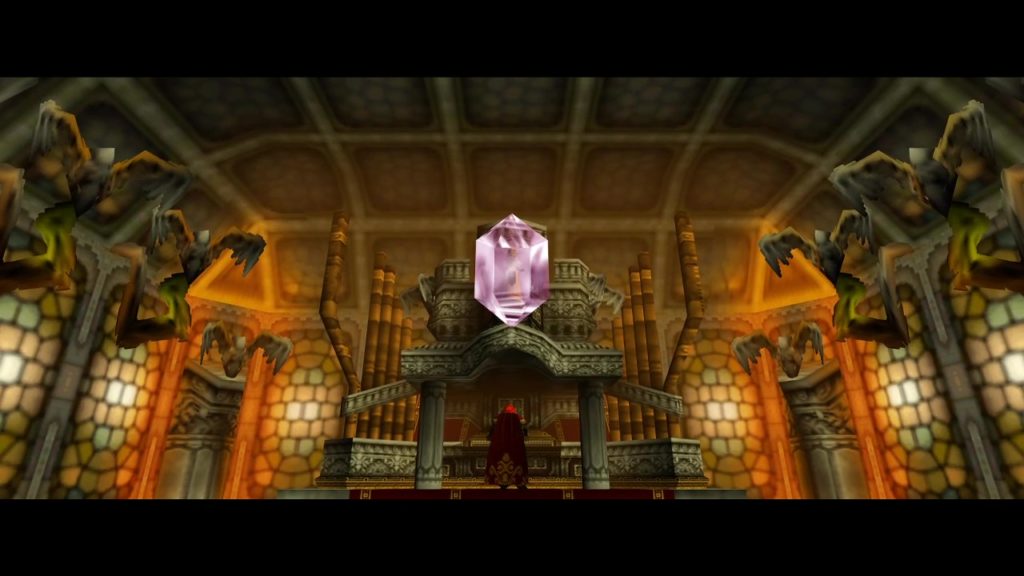
After he takes enough damage, Ganon uses the last of his power to destroy the castle with you inside it. Zelda has been freed from her crystal and the two of you descend the crumbling spire under a time limit with Zelda opening doors along the way. The time limit isn’t too strict, but there are several enemies and falling rocks on the way down, and Zelda stops to gasp with concern whenever you take damage, slowing you down.
At the bottom with Ganon’s Castle in ruin, Beast Ganon emerges from the rubble and promptly knocks away the Master Sword. This is a powerful moment as discussed before. Link’s sword is integral to his kit and a part of him. It is used in every boss fight in the game, not having it feels like you’re significantly weakened… Unless you have the Biggoron Sword. I don’t see a way around this because Ganon couldn’t knock both swords away from you, but it’s a shame that this moment can potentially fall flat.
As for the actual fight, Ganon’s sword swings can do a hefty amount of damage, but he’s so slow that getting behind him for sword swings if you have the Biggoron Sword or shooting him with Light Arrows is no challenge at all. After dealing enough damage, the player can retrieve the Master Sword for the final part of the fight. Ganon is a pretty straightforward fight so the only thing going for this fight is the plot significance and setting in a ruined castle. If I had to guess, I’d say Nintendo wanted the risk of dying during this fight to be low as it would interrupt such a climactic moment.
After bringing Ganon to his knees with the aid of Zelda’s magic, Link strikes a final, satisfying blow, stabbing Ganon through the skull (Rated E for Everyone) followed by the sages sealing Ganon away in the Sacred Realm.

Finally, Zelda returns us to the past and we see all of Hyrule’s locations restored, its inhabitants gathered for a party at Lon Lon Ranch. Link has set things back as they should be. We then see the sages gathered at the top of Death Mountain looking down over Hyrule. Link then arrives back in the past where Navi flies off, their business together having finished. We see Link and Zelda standing in her courtyard and the game ends, freezing on that screen.
This ending is a heartwarming goodbye to all of the characters we met along the way and it’s nice to see how many lives Link’s actions impacted.
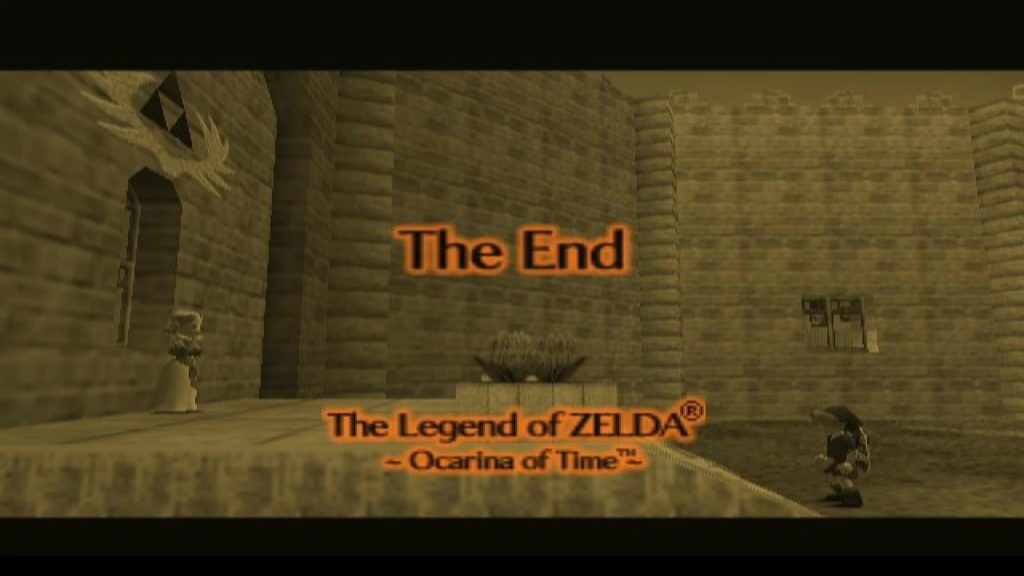
Summarizing
The Legend of Zelda: Ocarina of Time is not as I remember it. It has no where near the level of challenge I thought it had. That said, it is still a game very much worth playing. The game accomplishes a ton within its means.
The few locations that exist in the game are interesting visually and because of the people present. The collection of forest, volcanic mountain, lake, and desert provides the game variety and a sense of scale. There was a lot of foresight in the visual style for this game. Games of the time which strove for realism looked terrible then and they look terrible now. Choosing something which straddles realism and cartoonish visuals is a good compromise chosen for a 3D world in a fantasy setting and though the game doesn’t look good necessarily, it holds up much better than many games from the time and is lent some unique atmosphere by the dated graphics.
While speaking of presentation, this game’s crowning achievement is its music. The tunes played on the Ocarina and those in peaceful locations are excellent and catchy, particularly considering that the ones playable on the Ocarina only use five or so notes even in their extended form.
The term that comes to mind when thinking about the experience of this game as a whole is ‘lean’, but in the sense of efficiency rather than emptiness. This game gets a lot of flak for being linear, but I find it to be a shining strength of the game. Everything from presentation, mechanics, and plot is streamlined and significant. No location (except Hyrule Field), quest, or item goes to waste. The pacing of everything makes you feel as you are constantly being built up and given something new to accomplish. Even side content yields rewards which enhance your essential abilities. Every item save for two of the spells, masks, tradeable items, and Ice Arrows are essential. Most of you get in the game feels appropriately rewarding because it expands your capability in meaningful ways. The collection of items, equipment, health, and magic is just so tight.
Stray Thoughts and Minor Gripes
Before my concluding remarks, I’d like to list off some things which are nice details or minor gripes:
- I like the continual recurrence of items, enemies, etc. in sets of red, blue, and green
- The Zeldas and Gorons have excellent and distinct designs that feel believable
- It’s funny that after throwing the Bomb Flower over the fence to blow up the boulder blocking Dodongo’s Cavern, the Goron sitting there tells you “you’re so smart”
- I enjoy that child Link is able to use shields in multiple ways (standing or turtle) and adult Link loses this ability but can use multiple types of swords instead (one-handed or two-handed)
- Even while being held like an item, Ruto has idle animations
- The man who buys Poes from Link references being a prostitute instead of his current line of work saying: “If I looked as good as you I could run a different kind of business”
- The shortcut that you open up in the Shadow Temple isn’t even usable after you get on the boat right next to it
- The Light section in Ganon’s Castle is hot garbage. The solution to one of the rooms is finding a key in an invisible chest, the only thing in the room
- It’s laborious that the game always spawns you either in your house or the Temple of Time upon startup rather than where you were last
- Navi badgers you often and will keep badgering you until you speak to her
- Bottling items or receiving items from chests will always make you scroll through a tutorial on how to use it even if you’ve had the item before
- One of the puzzles in the Fire Temple resets after you complete it and leave the room, despite being a room you have to revisit
- Gold Skulltulas must be hit twice with the Boomerang to kill and you have to re-aim each time unable to lock-on, but only once with the Hookshot
- If you try to roll to gain speed to jump into Zora’s Domain from Zora’s River you end up reading the plaque on the ground
- Zelda’s Lullaby to solve puzzles is grossly overused
- The strategy that is best for fighting weapon-wielding enemies is just waiting (sometimes quite a while) for them to strike then counter-attacking
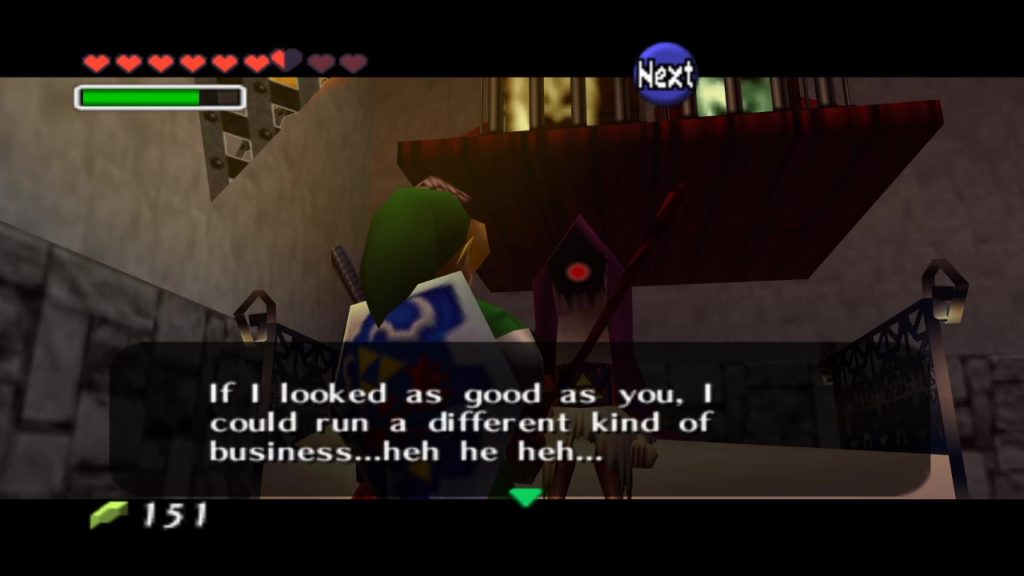
It’s Over.
My love for this game hasn’t waned in the slightest. It still was able to foster that feeling of being on an epic adventure where you become a stronger, better equipped force to take on a great evil. It may not be the deepest narrative, but the world that it takes place in and what you do there more than suffice to make this one of the greatest games and game worlds ever created, particularly for the time. It is telling that I know I will play this game again, and more telling that I know I’ll enjoy it.
If you made it this far, thanks for reading. I hope you let me know what you think.
Game content and materials are trademarks and copyrights of their respective publisher and its licensors.
Really good analysis man! I loved how you meant ones the melancholy nature of the game cuz I’ve only ever seen that talked about once. And that light section in Gabon’s castle is total hot garbage. Keep up the great work!!!
The melancholy thing is easy to overlook because of how upbeat most of the childhood sections are and how adventurous the whole thing feels. I know, the light room is like three steps below the other puzzle rooms in the castle. Thanks for reading, Ethan!